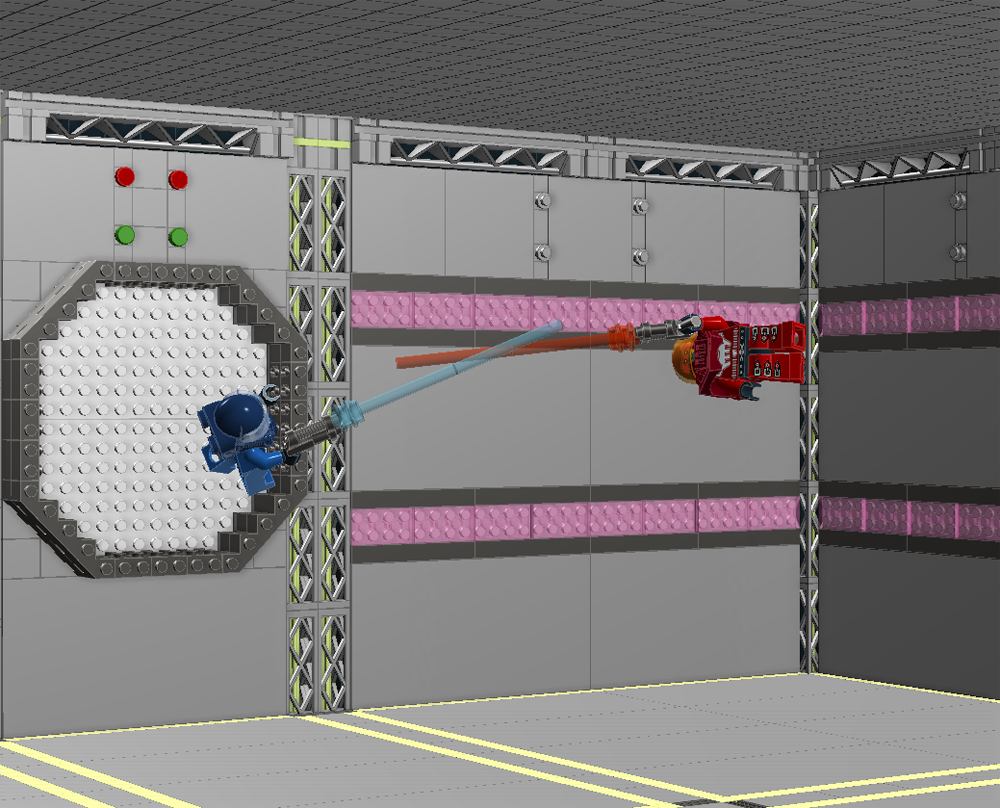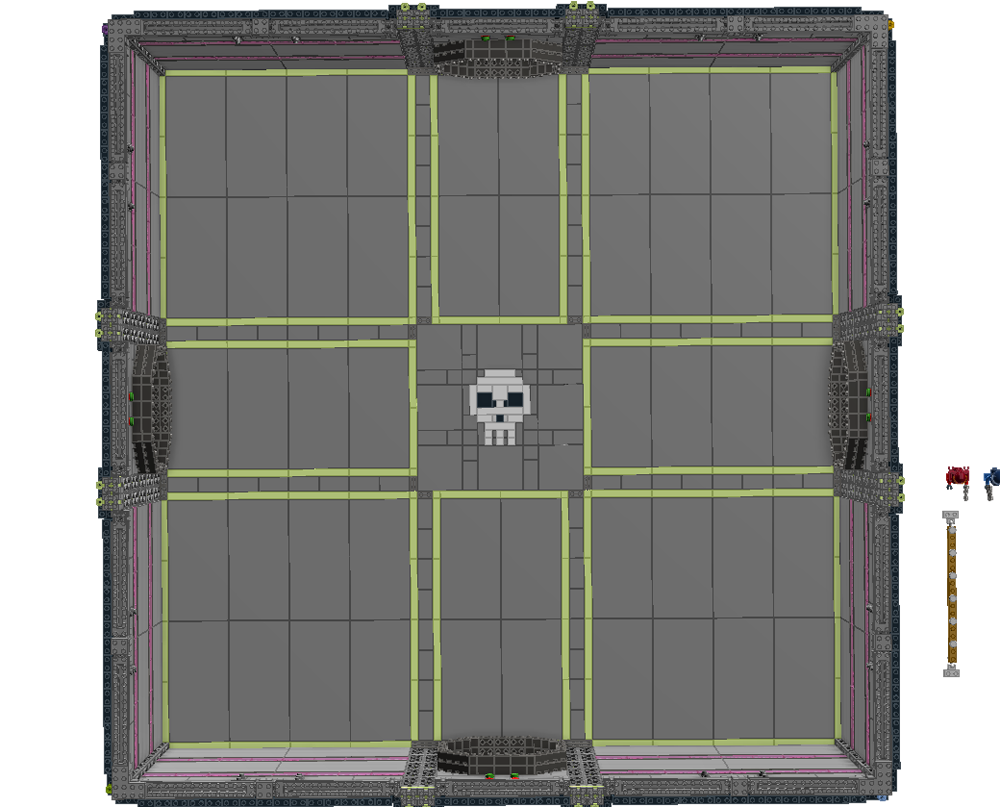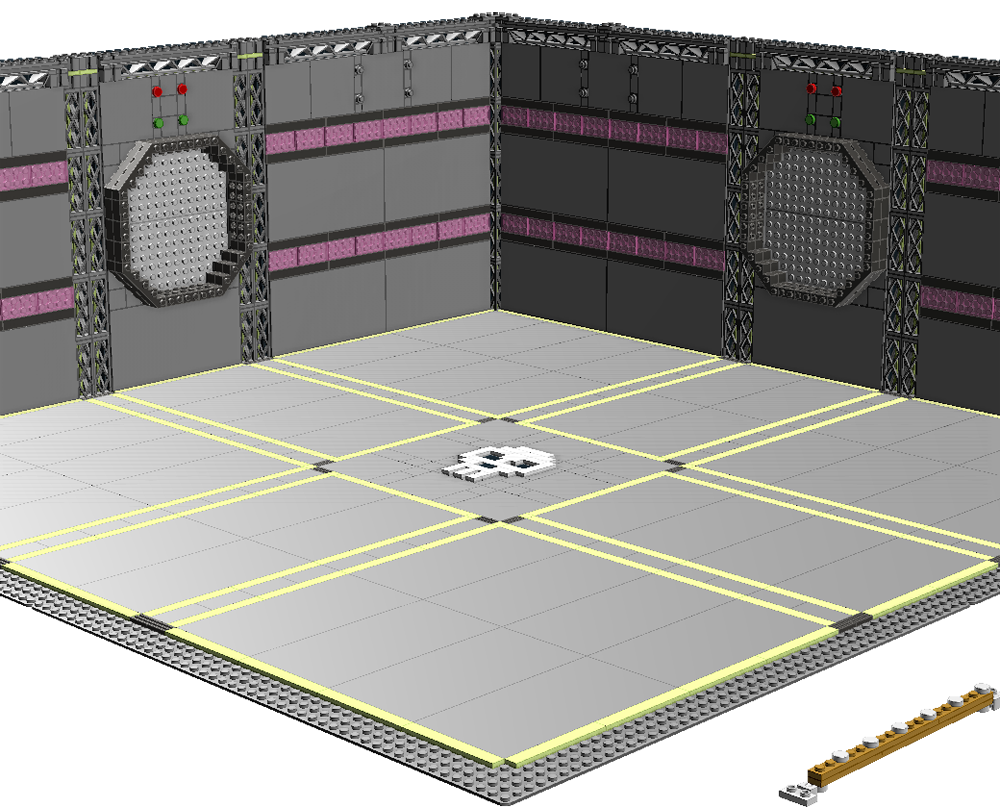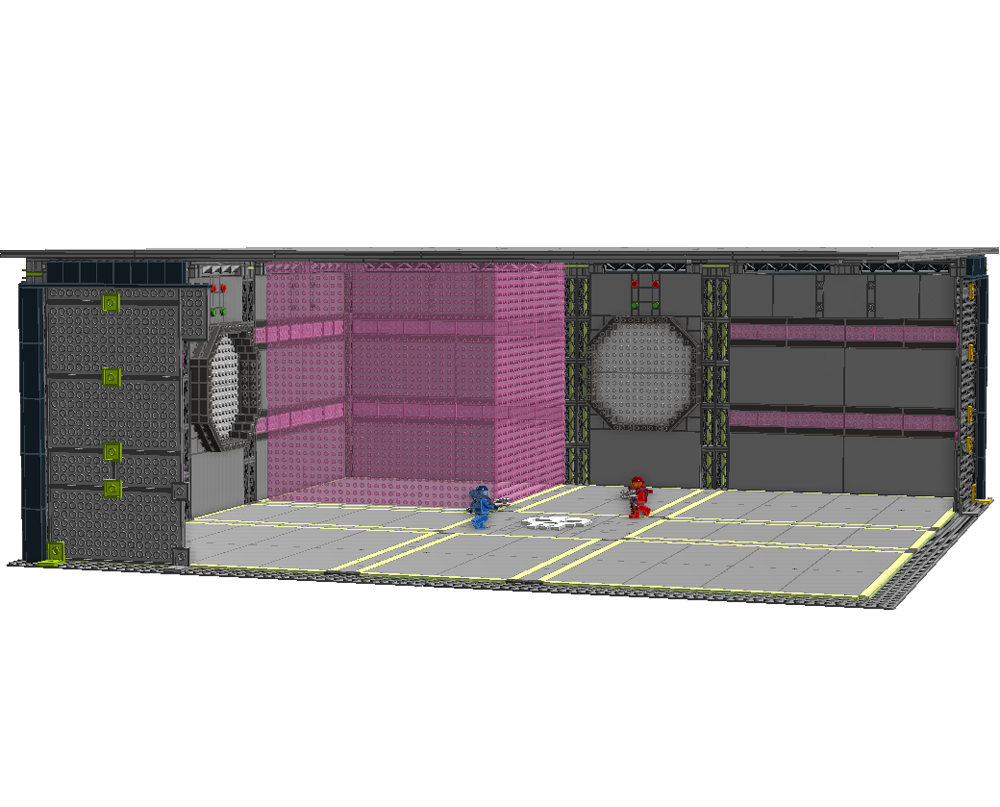|
|
| Line 47: |
Line 47: |
| | | | |
| | Here only a couple of the walls and one corner are Hidden. Combatants have been placed in the center of the arena to show the scale of the interior. Clearly, in this example, two Complications are being utilized. The Artificial Gravity has been turned on and the combatants are grounded. Also, the power conduits in the floors and walls are being used to create Force Walls, impassable barriers which exist to make the combatant's lives hell. | | Here only a couple of the walls and one corner are Hidden. Combatants have been placed in the center of the arena to show the scale of the interior. Clearly, in this example, two Complications are being utilized. The Artificial Gravity has been turned on and the combatants are grounded. Also, the power conduits in the floors and walls are being used to create Force Walls, impassable barriers which exist to make the combatant's lives hell. |
| − |
| |
| − |
| |
| − | == Death Bowl Basic Rules ==
| |
| − |
| |
| − |
| |
| − | === Sponsors ===
| |
| − |
| |
| − | Each real life Player is a Sponsor. Players can roleplay themselves, use one of their existing factions as a Sponsor persona, or create something entirely new. Sponsors maintain '''Rosters''' of Gladiators and have a '''Standing''' Score. Simply, the Sponsor gains 1 Gladiator for each 1 point of Standing they have and may organize those gladiators for events however they see fit. Standing increases by 1 for each win the Sponsor is responsible for and decreases by 1 for each loss (which results in a gain or loss of gladiators, accordingly). As of Season One, Standing is rated on a scale from 1-20, allowing a maximum roster of 20 Gladiators. Sponsors who reach 0 Standing are ousted from the games and must come up with a new persona to play again.
| |
| − |
| |
| − |
| |
| − | Beginning Sponsors may rank their Initial Standing on a scale from 1-10, based on whatever rationale makes sense. A megacorporation, for example, might have a Standing of 9 or 10 to start, thanks to their massive amount of resources. A lone dominus just entering the games with only a single Gladiator to his name, on the other hand, would begin at 1 Standing. This choice is left to the Player.
| |
| − |
| |
| − |
| |
| − | If a Player maintains a Sponsor Persona, each match they Host nets them 1 Standing. They may not participate in matches they Host.
| |
| − |
| |
| − |
| |
| − | === Gladiators ===
| |
| − |
| |
| − | Characters often train for months before becoming Gladiators so that by the time they enter the Arena, they're a cut above the average minifig. Gladiators are, by default, worth 5CP. When gaining new Gladiators, Sponsors can choose to build their own or take the Basic Package (a basic minifig with a Move of 7 instead of 5).
| |
| − |
| |
| − |
| |
| − | Each win the Gladiator helps to achieve nets him a payment of 1CP for him and 1CP for his Sponsor. The Gladiator can spend this CP to increase his Worth, gaining any Stat Increase, Specialty, or Supernatural Die he could afford at normal BrikWars costs. He may also save this CP over time. Weapons and equipment are provided freely to Gladiators and do not cost any CP whatsoever. The Sponsor can spend their CP to bid on Gladiators in the Open Pool.
| |
| − |
| |
| − |
| |
| − | When a Sponsor loses Standing, he loses access to Gladiators. Those Gladiators go into the Open Pool and can be drafted by anyone. A Sponsor who has an open point of Standing can start a Bidding War for any Gladiator in the Open Pool if he does not wish to simply gain another Basic Package Gladiator. Any Sponsor who also has an open Standing may participate in this Bidding War. Simply, the highest bidder wins the Gladiator, who is added to their Roster, and the CP spent on the bid is deducted from their accounts.
| |
| − |
| |
| − |
| |
| − | Every 3 wins (or 3CP Worth Increase) a Gladiator obtains, raises his Weight Class by 1. An 8CP Gladiator, for example, is a Tier 2 Gladiator, an 11 CP character is a Tier 3 Gladiator, and so on. Gladiators can compete within their own Weight Class freely (two Tier 3 Gladiators can face off in a 1v1 with no special considerations, for instance). However, each Tier of Weight Class makes the Gladiator count as one more minifig for purposes of facing off against lesser Gladiators. For example, a Tier 3 Gladiator is worth three minifigs so she can face off against three Tier 1s or a Tier 2 and a Tier 1 working together.
| |
| − |
| |
| − |
| |
| − | '''Alpha Wolf'''
| |
| − |
| |
| − | An Alpha Wolf is the most common Basic Package Gladiator. Born from a teleporter accident gone terribly awry, the Wolves are a countless collection of clones. Their original was a famously lucky minifig who was popular in the early days of Dis' death games circuit. Each is called Alpha Wolf because no one knows who the original is...or even if he's still alive. Many a Sponsor's Roster is buffered out with Alpha Wolves.
| |
| − |
| |
| − |
| |
| − | === Setting Up a Match ===
| |
| − |
| |
| − | One Player is chosen to be the Lead. This can be accomplished however the Players participating in the match would like. Random determination, a Bidding War, or a vote are all viable options. The Lead chooses the Event Type and, if applicable, the team sizes (which range from singles to teams of five). He then chooses (from his Roster) his first Gladiator. Players proceed in turn order choosing Gladiators from their own Rosters to join the fight. This selection method is used in consideration of Weight Classes. Maximum team size further restricts what Gladiators can be added.
| |
| − |
| |
| − |
| |
| − | ''Example: Quantum, Scratch, and Silver are having a match. Quantum wins the Lead. He chooses KillZone with 5 man teams. He then chooses a Tier 4 Gladiator as his first pick. Scratch responds by choosing four Tier 1s. Silver decides on two Tier 2s. Quantum's second pick is a Tier 3. Scratch is now restricted to choosing a Tier 1, 2, or 3 as he only has one team slot left to fill. If he wants to remain competitive, he'll choose as close to 3 as possible. Luckily, Scratch has a Tier 3 hero for the occasion. Silver picks another Tier 2 and a Tier 1 and the match is ready to begin.''
| |
| − |
| |
| − |
| |
| − | Notice that the Lead effectively sets the power level for the match and that the other players match it on a pick for pick basis. If the players all agree, this selection method can be replaced by simply choosing a Weight Class and a Team Size and making sure all Gladiators conform. For example, the three players above might decide to play a 3v3v3 with all Tier 2 Gladiators.
| |
| − |
| |
| − |
| |
| − | Once the event and gladiators are chosen, the Host either chooses, rolls randomly for, or gives to the Players choice over which Arena Complications to include in the match.
| |
| − |
| |
| − |
| |
| − | ==== Complications ====
| |
| − |
| |
| − | Complications are modifications to the Arena which alter the battle strategies from match to match. Hosts, if choosing themselves, are encouraged to create the nastiest and most interesting scenarios possible. The following Complications are the most common but the list isn't all inclusive. Hosts may feel free to make up their own Complications and Players may feel free to suggest them. Complications that see popular use will be later included here for reference.
| |
| − |
| |
| − |
| |
| − | ===== Artificial Gravity =====
| |
| − |
| |
| − | Artificial Gravity (or AG) can be toggled on or off. If on, combatants behave normally. If off, combatants require some sort of impetus to move around. Characters outfitted with thrusters of some kind are assumed to have nearly perfect maneuverability while in use. Otherwise, characters will continue moving in the same direction and at the same speed they moved last turn. Characters can adjust facing at will regardless.
| |
| − |
| |
| − | ===== Force Walls =====
| |
| − |
| |
| − | Force Walls can be programmed to spring up along any of the neon green lines on the floor or the neon pink bands on the walls. They can be programmed to occur in any number of ways. Most often they are assigned a random order unknown to the combatants before the match. There is a small subset of fans, however, who look forward to "PuzzleBox" KillZone matches, where the Walls appear in a discernible pattern and can be "solved" and utilized by wily, attentive combatants.
| |
| − |
| |
| − | ===== Obstacles =====
| |
| − |
| |
| − | Known by the more cowardly as "cover," this category of Complication basically just means "stuff in the way." In early focus group testing, space junk was used but the DB program has several themed sets being manufactured for use by the opener for Season One. It operates according to the normal rules for cover and terrain. In Zero-G, characters can use suitably massive objects as launchpoints to gain impetus or to create deadly projectiles. Common Sense rules apply here but Cinematic Rules take precedence.
| |
| | | | |
| | | | |
From the original advertisement:
Broadcasting LIVE from the Doom Moon of Dis some random weekend, inspired by concepts from Quantum, Colette, and Natalya and sponsored by Dissonance Industries and Entertainment, comes the ultimate in face smashing, gut wrenching, LDD based death games!
Join heroes and challengers alike from across the breadth of BrikWarsian space and time and watch them fight to the death in a cold hard, steel box! Revel in their struggles to prove dominance! Got a beef with some moron on the forums? PUNISH HIM! Have a good friend you actually get along with quite well? PUNISH HIM!
Now you don't need 15,000 minifigs or a 15 page argument to prove you're cooler than everyone else! You only need...to BRIKWAR!
Come before midnight and get 5CP off your drinks at the Four Rums! Pick your poison and douse your enemies in the fires of your undying hatred! Viewers at home: Don't forget to Like and Subscribe!

Sunday! Sunday! Sunday!
The Death Bowl Arena is a simple, highly reinforced, colossal steel box. Combatants willingly go in alive, hoping for victory in battle, but they don't always come out that way. Talks for secondary or even tertiary Arenas are underway at D.I.E. (to expand the brand) but, for now, there is only one Arena. To compensate, the DB creators have devised several event types and Complications (modifications to the arena that forcibly alter battle strategies) to keep the games fresh and the seats full.

Death Bowl Arena External View
Each of the walls, each of the corners, the floor, and the ceiling are all grouped for ease of Hiding and unobstructed screenshoting. Each Wall and each Corner is also color coded, for those to whom such a thing might be useful in quickly identifying the appropriate sections for Hiding. Also shown are two random minifigs for scale and an example swivel mounted ruler measuring approximately seven inches.

Death Bowl Arena Internal View
The Arena is split into nine zones: a central zone, four cardinal direction narrow zones, and four broad corner zones. These zones are used variously, depending on the Death Bowl Game Type. There are several drainage grates, including the eyes of the skull, near the center and edges of the arena to collect the blood and guts between each fight. There are four entrances to the Arena, one at each cardinal direction. They are situated several inches above the floor to assist in zero gravity fights but are not far enough away from the floor to cause harm when the AG is turned on. Each entrance gate is extremely reinforced, opening from the top and bottom only at the beginning and end of an event.

Death Bowl Arena Perspective View
A better view of the entrance gates, the lights above each, and the girders and power conduits which run throughout the arena. This view also helps give a sense of scale as the studs are easier to make out.

Death Bowl Arena Total Perspective
Here only a couple of the walls and one corner are Hidden. Combatants have been placed in the center of the arena to show the scale of the interior. Clearly, in this example, two Complications are being utilized. The Artificial Gravity has been turned on and the combatants are grounded. Also, the power conduits in the floors and walls are being used to create Force Walls, impassable barriers which exist to make the combatant's lives hell.




